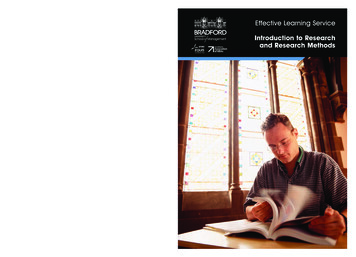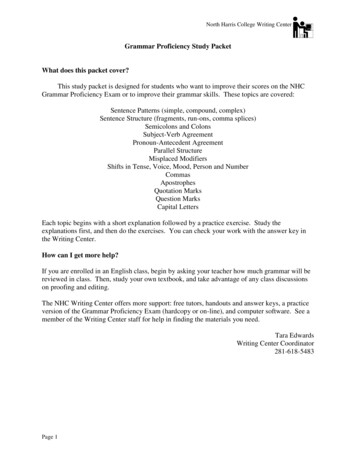
Transcription
Grace Hui Chin **************************A Case Study about Communication Strategiesas Translation **
Strategies for TranslationsThe purpose of this study was to identify what were Taiwanese University Englishas a Foreign Language (EFL) learners’ perceptions about learning communicationstrategies as well as suggested translation strategies. It collected qualitative dataabout students’ beliefs and attitudes as they learned communication strategies. Theresearch question guiding the study was: What are Taiwanese University EFL learners’perceptions about learning communication strategies for translating Chinese contextsin mind into English?Twenty-four university students were trained for 10 weeks to use strategies inFaerch and Kasper’s (1983a) taxonomy, and seven volunteers were interviewed. Noneof the students majored in English but were enrolled in a required Basic English coursein a Freshman English Non-Majors’ (FENM) program in Agriculture College at TunghaiUniversity. In the middle and at the end of the training period, participants wereinterviewed and videotaped for 90 minutes.The results were displayed clearly with details in Chapter four. In Chapter five,significant themes associated with topic avoidance (1.), message abandonment (2.),meaning replacement (3.), interlanguage (4.), and cooperation (5.) strategies,mentioned by seven participants were revealed through the constant method ofanalysis.They were comprehension, politeness, intentionality, native language, face-saving(losing-face), interlanguage system, time-saving, and keywords. Chapter six includesa summary of this study, further discussions for the important issues mentioned byprevious studies of this field and by participants of this research, and at the end,several important issues recommended as topics for further studies. The issuessuggested to readers for future researches were variables in the learners and trainers,students’ acceptance level of non-native like language, training pedagogies, therelationship between English proficiency and using strategy, the correlation betweengender and strategy, communication strategy in a working situation, and examplesthrough the interlanguage strategy.Grace Hui Chin Lin is a PhD from Texas A&M University, College Station, and also aMaster of Science, TESL from University of Southern California. Dr. Lin’s interests ofstudy are in fields of Translations, Applied Linguistics, Sociolinguistics, and TeachingEnglish.ISBN: 978-957-41-6666-4
ABSTRACTCommunication Strategies for TranslationBy Grace Hui-chin LinPh.D., Texas A&M University, College StationMaster of Science, University of Southern CaliforniaAssistant Professor, English Department, National Changhua University of EducationThe primary purpose of this case study was to identify what were TaiwaneseUniversity English as a Foreign Language (EFL) learners’ perceptions about learningcommunication strategies. This study collected qualitative data about students’ beliefsand attitudes as they learned communication strategies. The research question guiding thestudy was: What are Taiwanese University EFL learners’ perceptions about learning fivecommunication strategies?Twenty-four university students were trained for 10 weeks to use strategiesFaerch and Kasper’s (1983a) taxonomy, and seven volunteers were interviewed. None ofthe students majored in English but were enrolled in a required Basic English course in aFreshman English Non-Majors’ (FENM) program in Agriculture College at TunghaiUniversity. In the middle and at the end of the training period, participants wereinterviewed and videotaped for 90 minutes. The results were as follows:1) In the reduction set of communication strategies, seven volunteers tended toadmit that “topic avoidance” (1.) was applicable; however, they disagreedabout “keeping silence” because of their concern about politeness.iii
2) Students had mixed views about “message abandonment” (2.) that ranged froma neutral position to appropriate and inappropriate usages.3) In the meaning replacement strategy (3.), most of the students believed that itwas convenient to have access to getting to know their interlocutor’s intendedmeaning.4) In the second achievement set, four students perceived it was useful, but threestudents provided their vague attitudes with various suggestions for usage. Forthe interlanguage strategy (4.), six students noticed it offered a function ofenhancing their comprehensibility in English communication, and one studenthad a neutral attitude. The data revealed students had sufficient and complexperceptions about “word-coinage.”5) In the cooperation strategy (5.), six students believed it assisted them toachieve the purpose of learning, but two of seven students believed it waslosing face when appealing for help.6) The constant method of analysis revealed eight themes associated with topicavoidance (1.), message abandonment (2.), meaning replacement (3.),interlanguage (4.), and cooperation (5.) strategies, were mentioned by sevenparticipants. They were comprehension, politeness, intentionality, nativelanguage, face-saving (losing-face), interlanguage system, time-saving, andkeywords.iv
DEDICATIONThis book published in the united states is dedicated to my loving parents,Ming-Hsiung Lin, and Jan Ling-chou Lin. I appreciate their continuous sufficienteconomic support and powerful encouragement over the past 20 years, since I decided todevote myself into the academic field of Translation and Lingustics.Dedication also is extended to my sisters and brothers-in-law, Helen Hui-wenLin and Jan Perng, and Diane Hui-hwa Lin and Michael Hui-fong Liu, who havesupported my study in everyway either when I was in New York, California, Texas, in theUS, or in Taipei, Taichung, Changhua, in Taiwan. Because of you being around me, I candevelop my knowledge in the fields of Curriculum and Instruction, Sociolinguistics, andTeaching English as a Second Language. My first book published in the states isdedicated to my intelligent niece and nephew, Freeda Yi-ru Liu and Yorge You-cheng Liu.Their passionate faces appeared on web-cam inspired my study anywhere in the world. Ianticipate my academic research also will motivate them in their studies at school.I thank all of my supporters and mentors, who have been from time to timeconcerning about my progress for my challenging academic careers. They has beenkeeping me in their touch and emailing me regularly after I was back home in Changhua,Taiwan, teaching in English Department of National Changhua University of Education,after my long term Ph.D. study (2003 2007) and teaching out of my own hometown.Thank you, Dr. En-zen Jan (my own uncle), Dr. Paul Shih-chieh Chien (my colleagueduring teaching at National Sun-yat Sen University), Dr. Roger Hui-zung Perng atNational Changhwa university of Education. Thank you for taking care of me in Texas,Dr. Fackler and Naomi Fackler, Dr. Werner Rose and Beverly Rose, Dr. Laurine WilliamMarlow, Dr. Joel Lovell and Anni Lovell, and Dr. Larke. I wish to spend more time withyou and see you as often as possible.v
ACKNOWLEDGEMENTSI truly appreciate my advisors, teachers and friends, who have assisted me incontinuous devotion to academic field. First of all, I would like to thank advisors ofNational Changhua University of Education, providing me to teach as a teacher in thebest school of my hometown.Moreover, I would like to thank my previous colleague, Dr. Paul Shih-chiehChien, and my uncle, Dr. En-sen Jan, who have been supporting my academic career,through emailing and co-authoring. Their insightful leading throughout my researchingand teaching do make me feel pleasant about being scholar.My thankfulness is extended to my mother and my father who always keepencouraging me to devote my time, budget, and passion to teaching and learning. I trulyappreciate your kindness and patience on me. I respect your precious comments fromtime to time and you providing to me finical supports, which spiritually and realisticallybolster my motivations and courage to be an outstanding English teacher and a faithfulscholar.Finally, I have to thank my own sisters, Diane Hui-hwa Lin (Liu) and HelenHui-wen Lin (Pan), who also have been always accepting me whenever I am in good timeor bad time of life. Your love and patience are ones of the most important reasons why Iam able to achieve my PhD and successful academic career. Thank you very much!!!vi
TABLE OF CONTENTSPageABSTRACT . . . . . . .iiiDEDICATION . . .vACKNOWLEDGEMENTS . . . . . . .viTABLE OF CONTENTS . . . .viiLIST OF FIGURES . . xiiiCHAPTERIIIINTRODUCTION . . . . 1Statement of the Problem . . 5Statement of the Purpose . . . .6Research Questions . . . .6Significance of the Study . . . . 7Definitions . . . . . . .7Organization of the Study . . . .9LITERATURE REVIEW . . . . . . .11History and Trends of Communication Strategy . . 11IIIPsychological Status of Strategy Application . . .17Earlier Studies . . . . .22Recent Studies . . . . . . .24Theoretical Base/Conceptual Framework . . . . .28METHODOLOGY . . 34Qualitative Study . . . . 34Naturalistic Inquiry . . . .35The Rationalistic Design . . . . . .35vii
PageResearch Setting . 37University Levels in Taiwan . . .37History of Tunghai University. . . .37Participants’ English Level in Tunghai .38FENM Program in Tunghai, Required Basic EnglishCourse in Universities of Taiwan .38Sample Selection Criteria . . .39Seven Volunteers from Different Areas in Taiwan . . 40Individual’s English Learning Backgrounds . .40Instruments . . 43Prior Training .43Criteria of Five Communication Strategies Based onFaerch and Kasper’s Taxonomy . . . .43Instruments of Training Materials .44Instruments of Interviews . 45Data Collection . .46Procedures . . . 46Interview in an Honest Atmosphere . 47Ninety-Minute Interviews after 5 and 10Weeks of Training . . . . 47Data Analysis . . . . 48Analytic Procedures . . 48Thick Description . . 49Open Coding . . . 50viii
CHAPTERPageConstant Comparison Analysis . . . 51Credibility . . 52Open-ended Questions . . . .53Case Study . . . . .54Member Check . . . . . .55Peer Debriefing . . .57Conformability . . . 58DVD Notebook . . . .58Videotaping . . . . .58Trustworthiness . . 60Triangulation . . . 60Prolonged Engagement . . 62IVConfidentiality . . 63IRB Consent Form . . . . . .64Interview in Mother Tongue .64Face-to-Face Interview in Privacy . . .65Assumptions of the Study . .65Limitations of the Study . .66RESPONSE TO RESEARCH QUESTIONS . .67Analysis of the Interview . .67Research Question One .68What Do Taiwanese University Students Perceive inLearning the Topic Avoidance Strategy?.ix68
CHAPTERPageResearch Question Two . .88What Do Taiwanese University Students Perceive inLearning the Message Abandonment Strategy 88Research Question Three . .102What Do Taiwanese University Students Perceive inLearning the Meaning Replacement Strategy . 102Research Question Four . 117What Do Taiwanese University Students Perceive inLearning the Interlanguage Strategy?.117Research Question Five .145What Do Taiwanese University Students Perceive inVLearning the Cooperation Strategy? . . .145THEMES. . . 160Discussion of Perceptions . . .160Themes Emerged from Students’ Perceptions aboutthe Topic Avoidance Strategy . . 161Themes Emerged from Students’ Perceptions aboutthe Message Abandonment Strategy . . 163Themes Emerged from Students’ Perceptions aboutthe Meaning Replacement Strategy . 165Themes Emerged from Students’ Perceptions aboutthe Interlanguage Strategy . . 167Themes Emerged from Students’ Perceptions aboutthe Cooperation Strategy . 170x
CHAPTERPageConclusions . . .VI172DISCUSSIONS, SUMMARY AND RECOMMENDATIONS . 175Discussions. . . . .175Comprehension in Speeches . .176Politeness . . . .178Intentionality . . . .179Native Language . . . .182Face-Saving . . .183Affective Filter . . 185Time-Saving . . . . . 186The Correlation between Key Words and Willingnessto Communicate . . . . . .187Summary . . . 188Recommendations for Further Research Topics. .189Different Variables in the Learners and Trainers . 190Students’ Acceptance Level of Non-native LikeLanguage . .191Training Pedagogies . . . .192The Relationship between English Proficiency andUsing Strategy . . . .193The Correla
Figure 4.2. Perceptions of the Message Abandonment Strategy . 100 Figure 4.3. Perceptions of the Meaning Replacement Strategy . . . . 116 Figure 4.4. Perceptions of the Interlanguage Strategy . . . . 144 Figure 4.5. Perceptions of the Cooperation Strategy











